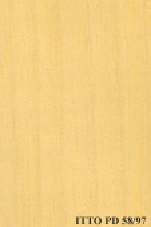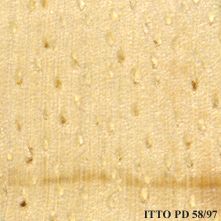
AKORET (Discoglypremna caloneura)
Trade Name
Akoret
Scientific Name
Discoglypremna caloneura Prain
Family
EUPHORBIACEAE
Common Names
Uguomafia (Nigeria); Akikagba (Nigeria); Akoret (Côte d`Ivoire); Atieghe (Gabon); Teka (Congo); Njila (Cameroon); Dambala (Cameroon); Uguomaiton; Uguomafia; Uguaomaifian; Shokushogwo; Okpaigwi; Okpaghegui; Ofretetre; Ofreh-tefreh; Obinwanyi; Nomanoma-gyama; Nnomanamegyama; Nanomanamedua; Leh-bohn; Hotorohotoro; Hotoro; Gbovui-hini; Fetaferai; Dubrafo; Dibimbi; Dein; Bovui-hini; Athieghe; Apohia; Akoret; Akikagba
Scientific Name Synonyms
Alchornea caloneura Pax
Description Of The Tree
Botanical Description
The tree reaches a height of 30 m. The bole is straight, clear and cylindrical, and up to 13 m long, with narrow buttresses. The trunk diameter attains 100 cm.
Natural Habitat
Discoglypremna caloneura occurs in evergreen forests, in secondary forests, and sometimes near water courses.
Wood Identification
Anatomic Description Of Wood
Wood diffuse porous. Occasionally vessels exclusively solitary (over 90%). Tangential diameter of vessel lumina 200 micras or more (large). Tyloses thin walled. Non-vestured pits. Vessels per mm2 less than 6 (rare). Simple perforation plates. Vessel-ray pits sim Apotracheal axial parenchyma diffuse and/or diffuse in aggregates. Prismatic crystals in non-chambered axial parenchyma cells. Prismatic crystals in short chains in chambered axial parenchyma cells. 5 to 8 cells per parenchyma strand. Rays more than 10 per mm (abundant). Rays non-storied. Rays 1 to 4 seriate. Prismatic crystals in radial alignment in procumbent ray cells (chambered cells). Prismatic crystals in the ray cells. Heterogeneous rays and/or multiseriate heterogeneous rays. Non-septate fibers. Fibers with distinctly bordered pits.
-
 Wood Macro Photo Tangential Plane
Wood Macro Photo Tangential Plane
-
 Wood Micro Photo Of Transversal Section
Wood Micro Photo Of Transversal Section
Availability
Cites Status
Unrestricted
General Wood Description
Color
The heartwood is from pale yellow to yellow-brown or white, it is not demarcated. Radial face shows some darker streaks and slight slivery figure.
COLOR INDEX (1=Black, 7=Light yellow,white)
7
Grain
Straight; grain has no particular influence on drying, machining and finishing qualities.
Texture
The wood is typically coarse in texture.
Natural Durability
Not durable; important risks of decay attacks at any processing step, from logs up to final products. It must receive preservative treatment. Sensible to termites attack. Heartwood is sensible to Lyctus attacks.
Natural durability index (1= Very high durability, 7=Vey low durability)
5
Silica Content
Silica Content: It is reported to have a negligible amount of silica. Contents over 0.05% may affect wood processing. Silica Value: 0.01
Wood Physical Properties
Basic Density or Specific Gravity (O.D. weight/vol. green) (g/cm³)
0.37
Air-dry Density (Weight and volume at 12%MC) (g/cm³)
0.40
Total shrinkage Tangential (Saturated to 0%MC) (%)
5.9
Total shrinkage Radial (Saturated to 0%MC) (%)
2.2
Drying Defects
Ease of Drying: Drying is rather slow and sometimes difficult to perform. Drying Defects: Risks of checks. Kiln Schedules: Schedule proposed as a reference by comparison with well known species taking into account to the general technological behavior of this species.
Dimensional stability ratio (Total Tangential Shrinkage %/Total Radial Shrinkage %)
2.8
Wood Chemical Properties
Wood Mechanical Properties
Bending Strength (MOR),12%MC (kgf/cm²)
560
Stiffness (MOE) 12%MC (kgf/cm²)
96516
Compression parallel to fiber 12%MC (kgf/cm²)
309
Compression perpendicular to fiber 12%MC (kgf/cm²)
33
Shear strength radial 12%MC (kgf/cm²)
52
Janka hardness (side) 12%MC (kgf)
192
Janka hardness (end grain) 12%MC (kgf)
281
Workability
Sawing
It is easy to saw.
Rotary Veneer Cutting
Not suitable for veneering.
Sliced Veneer
Not suitable for veneering.
Blunting Effect
Slight blunting effect; ordinary tools can be used for sawing and machining.
Machining
Machining of this species is reportedly easy.
Planing
Easy; no particular problems.
Moulding
Easy; no particular problems.
Turning
30
Boring
Easy; no particular problems.
Mortising
Easy; no particular problems.
Nailing
No particular problem.
Gluing
Glues well if basic gluing technical rules are followed.
Sanding
Particular care is needed to avoid woolly aspect of the surface.
Polishing
Needs pre-coating.
Response To Hand Tools
No particular problems.
REFERENCED USES
End Uses Summary
HOUSING GENERAL, flooring, fittings, FURNITURE AND CABINETS, cabinets, PLYWOOD AND VENEER, cores, TURNING, PACKING, CONTAINERS, truck bodies, truck flooring, NAVAL CONSTRUCTION, boats, OTHER AND MUSICAL INSTRUMENTS, matches, particleboard, paper
General Housing
- 10 - Silica in Timbers
Flooring
- 14 - Handbook of Hardwoods
Fittings
- 19 - Silica in Timbers
Furniture Cabinets
- 21 - Tropical timbers of the world. Part III-Southeast Asian and Oceanian Species.
Cabinet
- 24 - Empire Timbers
Panels, Veneers
- 25 - Directory of Timber Trade Malaysia
Cores
- 27 - Embassy of Brazil in Japan
Turning
- 30 - Embassy of Honduras in Japan
Packing
- 45 - Recopilación y Análisis de Estudios Tecnológicos de Maderas Peruanas
Truck Body
- 53 - Timbers of the New World
Truck Flooring
- 54 - Bulletin of the Government Forest Experiment Station N.157: Identification of Tropical Woods
Shipbuilding
- 55 - Tropical Timber Atlas of Latin America
Boats
- 56 - Manual de Identificación de Especies Forestales de la Subregión Andina.
Matches
- 71 - Proprietes physiques et mecaniques des bois tropicaux, premier supplement
Particleboard
- 80 - Estudio Integral de la Madera para Construcción
Paper
- 82 - Compilation of Data on the Mechanical Properties of Foreign woods (Part 2) Central and South America.
Please Provide Information To View Producer Information